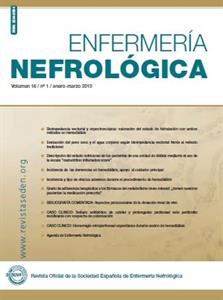Contenido del artículo principal
Resumen
La hemorragia retroperitoneal espontánea (Hre) engloba a toda extravasación de sangre al espacio retroperitoneal sin que exista traumatismo externo, manipulación endourológica o endovascular previa. Tiene múltiples etiologías, destacando la rotura de un aneurisma de aorta abdominal como causa más frecuente en adultos(1). Se ha observado mayor frecuencia de hemorragias en pacientes con terapia de anticoagulación y en pacientes sometidos a hemodiálisis por largo tiempo (posiblemente por la anticoagulación que conlleva su tratamiento intradialítico)(2), como es el caso que a continuación expondremos. Es una patología infrecuente, en la que a pesar de llegar al diagnóstico de una manera relativamente sencilla con estudios imagen, el poder determinar la etiología representa un reto y es motivo de múltiples estudios y procedimientos invasivos, algunas veces sin poder llegar a esclarecer la causa(3). La hemorragia retroperitoneal de origen renal fue observada por primera vez en 1700 por Bonet, siendo Wünderlich quien la define como “apoplejía espontánea de la cápsula renal” en 1856. Con posterioridad, Coenene en 1910 la designa con el término de “síndrome de Wünderlich”(4). La clínica fundamental está marcada por la llamada triada de Lenk: dolor lumboabdominal de comienzo brusco, masa palpable y shock hipovolémico. Siendo concretamente el dolor lumbar o abdominal el síntoma predominante. Los parámetros analíticos más relevantes son el descenso de la hemoglobina y hematocrito y la leucocitosis(1,5).
Palabras clave
Detalles del artículo
Derechos de autor 2013 Raquel F. Galiano Roa, Joaquín Olmedo Bravo de Mansilla, Elisa Ropero Linán

Esta obra está bajo una licencia internacional Creative Commons Atribución-NoComercial 4.0.
Aviso de derechos de autor/a
© Los autores ceden de forma no exclusiva los derechos de explotación de los trabajos publicados y consiente en que su uso y distribución se realice con la Licencia Creative Commons Atribución - No comercial 4.0 Internacional (CC BY-NC 4.0). Puede consultar desde aquí la versión informativa y el texto legal de la licencia. Esta circunstancia ha de hacerse constar expresamente de esta forma cuando sea necesario.
Referencias
- Pode D, Caine M. Spontaneus retroperitoneal hem-orrhage. J Urol. 1992; 1147(2):311-318.
- González C, Penado S, Llata L, Valero C, Riancho JA. The clinical spectrum of retroperitoneal hema-toma in anticoagulated patients. Medicine 2003; 82: 257-262.
- RG Casey, CG Murphy, DP Hickey, TA Creagh. Wunderlich ́s síndrome, an unusual cause of the acute abdomen. Eur J Radiol 2006, Vol 57: 91-93.
- Peña Porta JM, Pernaute Lavilla R. Síndrome de Wünderlich en paciente en hemodiálsis con enfermedad quística renal adquirida. Aportación de un nuevo caso. Actas Urol Esp. 1999;23(1): 76-78.
- Ratcliffe PJ, Dunnill MS, Oliver DO. Clinical importance of acquired cystic disease of the kidney in patients undergoing diálisis.1983. Br. Med J.; 287: 1855-1858.
- Ivascu FA, Janczyk RJ, Bair HA, Bendick PJ, How-ells GA. Spontaneus retroperitoneal Hemorrhage. Am J Surg. 2005; 189(3): 345-347.
- Machuca Santacruz J, Julve Villalta E, Galacho Bech A, Pérez Rodríguez D, Quiñonero DíazA, Alonso Borrego JM. Hematoma retroperitoneal espontáneo: nuestra experiencia. Actas Urol Esp. 1992;189(3):345-347.
Referencias
Pode D, Caine M. Spontaneus retroperitoneal hem-orrhage. J Urol. 1992; 1147(2):311-318.
González C, Penado S, Llata L, Valero C, Riancho JA. The clinical spectrum of retroperitoneal hema-toma in anticoagulated patients. Medicine 2003; 82: 257-262.
RG Casey, CG Murphy, DP Hickey, TA Creagh. Wunderlich ́s síndrome, an unusual cause of the acute abdomen. Eur J Radiol 2006, Vol 57: 91-93.
Peña Porta JM, Pernaute Lavilla R. Síndrome de Wünderlich en paciente en hemodiálsis con enfermedad quística renal adquirida. Aportación de un nuevo caso. Actas Urol Esp. 1999;23(1): 76-78.
Ratcliffe PJ, Dunnill MS, Oliver DO. Clinical importance of acquired cystic disease of the kidney in patients undergoing diálisis.1983. Br. Med J.; 287: 1855-1858.
Ivascu FA, Janczyk RJ, Bair HA, Bendick PJ, How-ells GA. Spontaneus retroperitoneal Hemorrhage. Am J Surg. 2005; 189(3): 345-347.
Machuca Santacruz J, Julve Villalta E, Galacho Bech A, Pérez Rodríguez D, Quiñonero DíazA, Alonso Borrego JM. Hematoma retroperitoneal espontáneo: nuestra experiencia. Actas Urol Esp. 1992;189(3):345-347.




